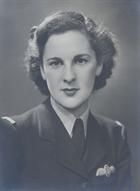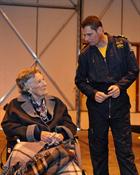Lady pilot relives WWII with the Fleet Air Arm
Aged 94 , Mrs Mary Villiers remembered her efforts during the Second World War as a pilot delivering hundreds of aircraft for the Royal Navy’s Fleet Air Arm (FAA) and RAF.
Mary was a VIP visitor to the Royal Naval Historic Flight at Royal Naval Air Station Yeovilton (RNAS) where she came face to face with one of the aircraft types, the Swordfish; she delivered when serving alongside men in the Air Transport Auxiliary (ATA) during the Second World War.
Mary, a great grandmother from Leigh near Sherborne, flew over 25 different aircraft types, said;
“I delivered the Swordfish to Naval Air Stations in Scotland, seeing the Swordfish it reminds of the scramble up the side using 5 footholds, swinging a leg over the side and dropping down into the pilot’s seat. I recall it being rather cold”
As Lt Commander Chris Gotke, Commanding Officer of the Royal Naval Historic Flight took Mary for a look around she explained how she joined at the age of 24 and clocked up 500 flying hours between June 1943 and the end of October 1945 when she left the ATA. Previously a driver before joining the ATA she said;
“When I saw the chance of getting into flying I took it. They were so short of Pilots that they were grateful for anyone with enthusiasm. There was no better job” as she was escorted by Lt Cdr Chris Gotke they took a look at the Sea Fury Mary added “that’s what I like, I wouldn’t mind flying that”!
She joined the ATA at the beginning of the War and volunteered to fly. After training on the Miles Magister, she went on to fly over 25 different aircraft types for both the Fleet Air Arm and the RAF including the Harvard, Barracuda, Hurricane, Swordfish, Spitfire and Wellington Bomber to name but a few!
One of 166 women in the ATA, Mary flew aircraft all over Britain from factories to operational Squadrons. She recalled a particular incident when flying a Wellington Bomber;
“Wellingtons are quite big. Once when I was taking off a hatch at the front flew open and everything, all of my maps flew down to the tail end. It wasn’t my fault the engineer should have checked the hatch. I didn’t have the maps for guidance but it didn’t matter I had learned where I was going and it wasn’t very far!”



